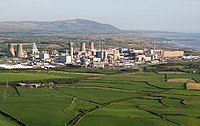
Photo from wikipedia
Pb, Cu, Zn, Mn, and Cr were removed from municipal solid waste fly ash through chloride volatilization method using poly(vinyl chloride) (PVC) as the chlorinating agent. To investigate the effective… Click to show full abstract
Pb, Cu, Zn, Mn, and Cr were removed from municipal solid waste fly ash through chloride volatilization method using poly(vinyl chloride) (PVC) as the chlorinating agent. To investigate the effective utilization of PVC, chloride volatilization at 700–900 °C was conducted for 0–120 min under three conditions: elevated heating (~ 40 °C/min), isothermal heating, and isothermal heating with Ca(OH) 2 as a HCl trapping agent. PVC was a better chlorinating agent than CaCl 2 and removed ~ 100% Pb and Zn and ~ 50% Cu and Mn by isothermal heating at 900 °C for 120 min. Ca(OH) 2 reduced Pb removal at 700 °C by ~ 20% and Cu removal at 900 °C by ~ 50%; however, it promoted Zn volatilization by 10–20% at all temperatures. The effects of co-existing elements on the chloride volatilization behaviors of these heavy metals were determined by conducting thermodynamic simulations under equilibrium conditions. The combined experimental and thermodynamic approach suggested that Pb and Zn were mainly volatilized as metal chlorides via reaction with the HCl produced by PVC pyrolysis, whereas Mn was volatilized by both CaCl 2 and Na 2 O. Thus, CaO, CaCO 3 , MgO, and residual carbon in fly ash could inhibit the chlorination of Pb, Cu, and Cr.
Journal Title: Journal of Material Cycles and Waste Management
Year Published: 2020
Link to full text (if available)
Share on Social Media: Sign Up to like & get
recommendations!